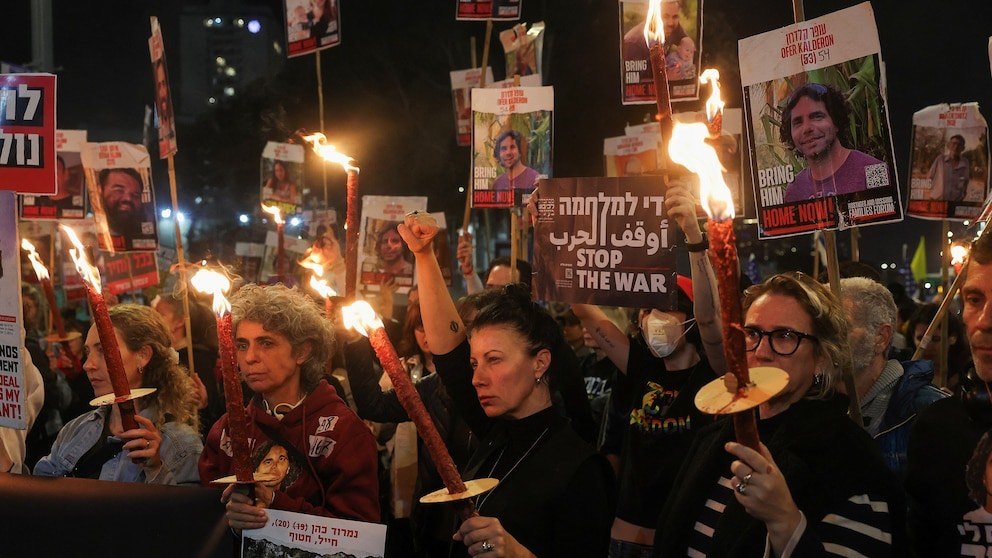Hostage and Ceasefire Deal Reached Between Hamas and Israel beginning Sunday.
Supporters of Israeli hostages, who were kidnapped during the deadly October 7, 2023, attack by Hamas, attend a protest to demand a deal to bring every hostage home at once, amid Gaza ceasefire negotiations, in Tel Aviv, Israel, Jan. 15, 2025. Zvulun/Reuters
In a significant breakthrough after over 15 months of intense conflict and violence in Gaza, a ceasefire and hostage deal has been reached between Hamas and Israel, President Joe Biden announced Wednesday. The agreement, brokered with the help of Qatar, Egypt, and the United States, sets the stage for a potential end to the prolonged war but still requires ratification by Israel’s Cabinet.
If approved, the deal will be implemented in three phases, addressing immediate humanitarian concerns, hostage releases, and long-term reconstruction efforts.
Phase One: Immediate Action
Phase one is set to begin Sunday, marking the start of a six-week ceasefire:
• Hostage Release: Thirty-three hostages of nearly 100 held in Gaza are to be released during this phase. However, reports suggest that more than half of the hostages may not be alive.
• Israeli Withdrawal: Israeli forces will withdraw from Gaza’s densely populated areas, allowing displaced Palestinians to return to their devastated neighborhoods.
• Humanitarian Aid: Hundreds of trucks carrying food, medicine, and essential supplies will enter Gaza daily to address the dire needs of its population.
• Prisoner Exchange: Negotiators are finalizing the list of hundreds of Palestinian prisoners to be freed in exchange for hostages.
President Biden expressed optimism, stating, “This is a step toward a better future. We’re handing the next administration a real opportunity for a more stable Middle East.”
Trump’s Role in the Process
President-elect Donald Trump has been vocal about his expectations for resolving the crisis before his inauguration on Monday. Speaking at Mar-a-Lago weeks prior, he warned, “All hell will break loose if those hostages aren’t released before I get into office.” Trump’s special envoy to the Middle East, Steve Witkoff, played an instrumental role by meeting with Israeli Prime Minister Benjamin Netanyahu over the weekend to emphasize the urgency of finalizing the agreement.
Phase Two: Addressing the Tough Challenges
Phase two, set to start on Day 16 of the ceasefire, will tackle more complex issues:
• Full Hostage Release: All remaining hostages, including male Israeli soldiers, are to be freed.
• Complete Withdrawal: Israeli forces would leave Gaza entirely, but only if Hamas’ military and political infrastructure is dismantled, a condition firmly stated by Israel.
• Hamas’ Position: Hamas has said it will not release the final hostages until Israeli troops withdraw entirely, signaling potential obstacles in this phase.
U.S. President Joe Biden said talks will go beyond the temporary ceasefire to a phase two of the deal that could include “a permanent end of the war,” as he officially announced the agreement.
Phase Three: Reconstruction and Reconciliation
The final phase focuses on long-term recovery in Gaza:
• Hostage Remains: The bodies of any remaining hostages in Gaza will be returned.
• Rebuilding Gaza: Reconstruction efforts will begin, but the process is expected to take decades, with no clear resolution on who will fund the extensive rebuilding.
Mixed Reactions
In Gaza, the announcement sparked celebrations, with many Palestinians cautiously hopeful about the ceasefire. “Is it real? Have they signed?” one resident asked, reflecting both optimism and skepticism.
Meanwhile, international observers view the deal as a rare opportunity for peace in the region. However, experts caution that the success of the agreement depends on the commitment of all parties to adhere to the outlined terms, particularly during the sensitive second phase.
Moving Forward
The agreement offers a fragile path toward peace, but with deep-seated tensions and political complexities, its implementation remains uncertain. Whether this deal becomes a foundation for lasting peace or another temporary halt in a cycle of violence will depend on the actions of leaders and mediators in the coming weeks.

